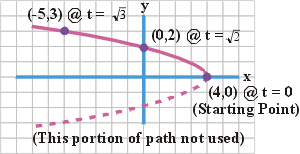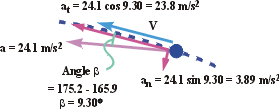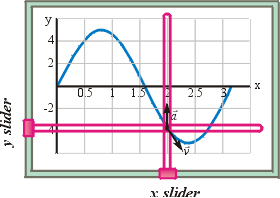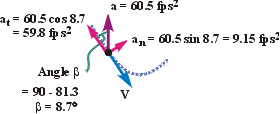Example 2-3: Use of Parametric Equations
A particle moves along a path described by the vector equation
![]()
with
R given in meters and
time in seconds.
(a) Determine
the path equation;
(b) Plot
the path;
Also determine
(c) The velocity and acceleration vector
equations;
(d) The position, velocity, and acceleration
vectors at time t =
![]() sec;
sec;
(e) The
angle between the acceleration vector and the velocity vector;
(f) The
normal and tangential components of acceleration.
(a) Eliminate time t from the parametric equations
![]()
and
![]()
to
obtain the path equation:
![]()
(b) Plot the path. Note that though the path shows both an upper and lower leg, the particle only moves along the upper leg.

(c)
Velocity and acceleration vector equations are found from time derivatives
of the vector position equation.


(d)
At time t =
![]() sec, the position, velocity and acceleration vectors are, in
both cartesian and polar form:
sec, the position, velocity and acceleration vectors are, in
both cartesian and polar form:

(e)
The angle, b,
between the v and
a vectors, as shown above, is 9.30°.
(f)
The normal and tangential components of acceleration (shown above)
are easily found once b
is known.
Note:
The angle b
between v and
a
can also be found from the dot product:
![]()
Thus,
![]()



